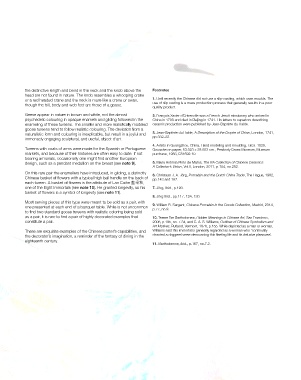Page 223 - Bonhams May 16, 2019 London Asian Art
P. 223
the distinctive length and bend in the neck and the knob above the Footnotes
head are not found in nature. The knob resembles a whooping crane
or a red headed crane and the neck is more like a crane or swan, 1. Until recently the Chinese did not use a slip-casting, which uses moulds. The
though the bill, body and web feet are those of a goose. use of slip casting is a mass production process that generally results in a poor
quality product.
Geese appear in nature in brown and white, not the almost 2. François Xavier d’Entrecolle was a French Jesuit missionary who arrived in
psychedelic colouring in opaque enamels and gilding followed in the China in 1798 and died in Beijing in 1741. His letters to superiors describing
enameling of these tureens. The smaller and more realistically modeled ceramic production were published by Jean-Baptiste du Halde.
goose tureens tend to follow realistic colouring. The deviation from a
naturalistic form and colouring is inexplicable, but result in a joyful and 3. Jean-Baptiste du Halde, A Description of the Empire of China, London, 1741,
immensely engaging sculptural, and useful, object d’art. pp.332–33.
4. Artists in Guangzhou, China, Hand modeling and moulding, circa. 1825,
Tureens with coats of arms were made for the Spanish or Portuguese Gouache on paper, 53.023 x 39.053 cm., Peabody Essex Museum, Museum
markets, and because of their histories are often easy to date. If not purchase, 1983, E81592.10.
bearing armorials, occasionally one might find another European
design, such as a pendant medallion on the breast (see note 9). 5. Maria Antónia Pinto de Matos, The RA Collection of Chinese Ceramics:
A Collector’s Vision, Vol.II, London, 2011, p.104, no.252.
On this rare pair the enamellers have introduced, in gilding, a distinctly 6. Christaan J. A. Jörg, Porcelain and the Dutch China Trade, The Hague, 1982,
Chinese basket of flowers with a typical high bail handle on the back of pp.143 and 167.
each tureen. A basket of flowers is the attribute of Lan Caihe 藍采和,
one of the Eight Immortals (see note 10). He granted longevity, so his 7. Jörg, Ibid., p.190.
basket of flowers is a symbol of longevity (see note 11).
8. Jörg Ibid., pp.117, 124, 130.
Most serving pieces of this type were meant to be sold as a pair, with
one presented at each end of a banquet table. While is not uncommon 9. William R. Sargent, Chinese Porcelain in the Conde Collection, Madrid, 2014,
to find two standard goose tureens with realistic coloring being sold p.77, no.9.
as a pair, it is rare to find a pair of highly decorated examples that 10. Terese Tse Bartholomew, Hidden Meanings in Chinese Art, San Francisco,
constitute a pair. 2006, p.195, no. 7.34, and C. A. S. Williams, Outlines of Chinese Symbolism and
Art Motives, Rutland, Vermont, 1976, p.155. While depicted as a man or woman,
These are exquisite examples of the Chinese potter’s capabilities, and Williams said this immortal is generally regarded as a woman who ‘continually
the decorator’s imagination, a reminder of the fantasy of dining in the chanted a doggerel verse denouncing this fleeting life and its delusive pleasures’.
eighteenth century.
11. Bartholomew, Ibid., p.167, no.7.2.

